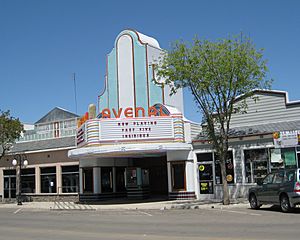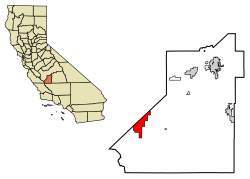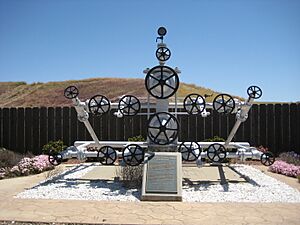Avenal, California facts for kids
Quick facts for kids
Avenal, California
|
||
|---|---|---|
| City of Avenal | ||

The Avenal Theater in 2011
|
||
|
||

Location of Avenal in Kings County, California
|
||
| Country | ||
| State | ||
| County | ||
| Incorporated | September 11, 1979 | |
| Area | ||
| • Total | 19.48 sq mi (50.46 km2) | |
| • Land | 19.48 sq mi (50.46 km2) | |
| • Water | 0.00 sq mi (0.00 km2) 0% | |
| Elevation | 807 ft (246 m) | |
| Population
(2020)
|
||
| • Total | 13,696 | |
| • Density | 702.97/sq mi (271.42/km2) | |
| Time zone | UTC-8 (Pacific (PST)) | |
| • Summer (DST) | UTC-7 (PDT) | |
| ZIP code |
93204
|
|
| Area code | 559 | |
| FIPS code | 06-03302 | |
| GNIS feature IDs | 1660285, 2409764 | |
Avenal is a city in Kings County, California, United States. Its name comes from the Spanish word for "oat field" (avenal). This is because the area used to be covered with tall, wild oats.
Avenal is about 35 miles southwest of Hanford. It sits at an elevation of 807 feet (246 meters). The city is part of the Hanford–Corcoran Metropolitan Area. Avenal is the fourth-largest city in Kings County by area.
In 2020, Avenal had a population of 13,696 people. This number includes people living at the Avenal State Prison. Many residents work at the prison or in farming. The prison provides around 1,000 jobs.
Contents
Avenal's Story: From Oats to Oil to Today
How Avenal Got Its Name
The name Avenal was given by early Spanish soldiers and explorers. In Spanish, avena means "oats," and avenal means "oatfield." This area was once full of wild oats that looked like golden silk.
The Oil Boom Years
American settlers came to the Kettleman Hills in the 1850s, hoping to farm and raise cattle. But it was oil that truly changed the area. Native Americans already knew about the oil, as it naturally seeped from the ground.
The first oil well in Kettleman Hills was drilled in 1900. Many tries after that were not successful. Then, on October 5, 1928, something amazing happened. The Milham Exploration Company's "Elliot No. 1" well blew out. The roar could be heard 20 miles away! This well produced a very light, clear oil. People even said it could be used as gasoline without being refined.
This oil discovery turned Avenal into a "boomtown." In 1929, Standard Oil planned the current city site. They moved houses from Taft to replace tents. Water and sewer systems were built. A post office opened, and a fire department was started. Standard Oil even built a 600-seat theater and a hospital for the residents.
By 1936, Avenal had about 3,000 people, mostly oil workers. It had 100 businesses. By 1940, Avenal was the second-largest town in Kings County. It was known for having great services and schools.
Avenal was once called the "Oil Fields Capital." Today, its economy mainly relies on the Avenal State Prison and farming.
Building a Community
When Avenal was first growing, many businesses opened. These included welding shops, supply companies, coffee shops, and grocery stores. The town quickly became a busy place.
To keep the community safe, a local court system was set up. A justice of the peace and a constable were appointed. A deputy sheriff also helped keep order.
In 1934, Avenal formed its own fire district. They had fire trucks and trained firefighters. The fire chief and his team worked hard to protect the town.
An emergency hospital was also built. Doctors and nurses cared for many people each month. They even offered ambulance services.
The first post office in Avenal opened in 1929. It was first in a general store, then moved to a larger building. Later, it moved to its current location near Skyline Boulevard.
Changes Over Time
Over time, the oil production in Avenal slowed down. Many businesses closed, and houses became empty. But in the 1960s, more farm workers moved to the area. This helped Avenal grow again.
In the early 1970s, two big projects helped the city. The California Aqueduct brought much-needed water to the area for farming. Also, Interstate 5 was completed, making travel easier.
In September 1979, the citizens of Avenal voted for the city to become officially incorporated. This meant it could govern itself. The community then worked to bring a state prison to Avenal. The Avenal State Prison opened in 1987. It became a very important part of the community, providing many jobs.
Avenal is also home to the Central California Soaring Club. This club operates at the Avenal Gliderport, which is one of the few airports just for gliders in the western United States. They even hold a soaring contest there every spring.
The city has also improved its roads and sidewalks. The Avenal Police Department started in 2010 with 14 officers.
Avenal's future is no longer just about oil. But the city will always remember its beginnings as an oil boomtown.
Where is Avenal?
Avenal is located at 36°00′15″N 120°07′14″W / 36.00417°N 120.12056°W. It is about 180 miles north of Los Angeles and 200 miles south of both San Francisco and Sacramento. The city likes to say it's "Half the way from the Bay to L.A."
Avenal covers about 19.4 square miles (50.4 square kilometers) of land. Most people live in the southwestern part of the city. The northeastern areas, separated by hills, are mostly rural. This is where Interstate 5 passes through.
Avenal's Weather
Avenal has a semi-arid climate. This means it has hot, dry summers and mild, wet winters.
People and Community
| Historical population | |||
|---|---|---|---|
| Census | Pop. | %± | |
| 1960 | 3,147 | — | |
| 1970 | 3,035 | −3.6% | |
| 1980 | 4,137 | 36.3% | |
| 1990 | 9,770 | 136.2% | |
| 2000 | 14,674 | 50.2% | |
| 2010 | 15,505 | 5.7% | |
| 2020 | 13,696 | −11.7% | |
| U.S. Decennial Census | |||
Avenal is a small city with about 13,696 people, including those at the prison. The city grew quickly after oil was discovered in 1928. By 1940, Avenal was the second-largest town in Kings County.
Today, Avenal's economy is based on oil, farming, and services. The Avenal State Prison helps the community stay strong economically. This is especially true as the oil fields produce less oil.
Who Lives in Avenal? (2010 Census)
In 2010, Avenal had 15,505 people. About 58.6% of the population lived in homes, while 41.4% were in institutions like the prison.
The population was made up of different groups:
- 39.0% White
- 10.5% African American
- 1.2% Native American
- 0.7% Asian
- 46.4% from other races
- 2.2% from two or more races
About 71.8% of the people were Hispanic or Latino.
There were 2,222 households. Many households (64.7%) had children under 18. The average household had about 4 people.
The population's age spread was:
- 21.4% under 18
- 10.7% aged 18 to 24
- 38.9% aged 25 to 44
- 25.0% aged 45 to 64
- 4.0% aged 65 or older
The average age in Avenal was 34.2 years.
Avenal's Economy
The Avenal State Prison is a major employer in Avenal, with over 1,500 people working there. Other big employers include The Wonderful Company and the Reef-Sunset Unified School District.
The city is working to bring more businesses and industries to the area. They are looking at developing the land near Interstate 5 for new companies.
In 2008, a large power plant was proposed for Avenal. It would have generated electricity using natural gas. However, after many years of discussions and legal challenges, the company decided not to build the power plant in 2015.
Many people in Avenal work in farming. This industry grew a lot after the California Aqueduct was built in the 1970s. However, farming has faced challenges from droughts and water restrictions. In November 2016, the unemployment rate was 12.7%.
In 2013, the City Council declared Avenal the "Pistachio Capital of the World." This shows how important the pistachio industry is to the city's economy.
Getting Around Avenal
Avenal is located where California State Route 269 and California State Route 33 meet. The intersection of Route 269 and Interstate 5 is just north of Avenal.
Kings Area Regional Transit provides bus service between Avenal and Hanford.
FlixBus also stops in Avenal, connecting the city to Los Angeles and the Bay Area.
Culture and Fun
Avenal has an annual event called "Avenal Old Timers Day." It is held on the first weekend in May. The city also celebrates an annual Pistachio Festival.
Learning in Avenal
All the schools in Avenal are part of the Reef-Sunset Unified School District (RSUSD).
Here are the schools in the district:
- Avenal Elementary School (Kindergarten to 6th grade)
- Tamarack Elementary School (Kindergarten to 5th grade)
- Reef-Sunset Middle School (6th to 8th grade)
- Avenal High School (9th to 12th grade)
- Sunrise Continuation School (9th to 12th grade)
- Adelante Continuation School (9th to 12th grade)
- Kettleman City Elementary School (Kindergarten to 12th grade)
- Avenal Adult School
West Hills College Coalinga is a college located in Coalinga, about 18 miles (29 km) northwest of Avenal.
Famous People from Avenal
- Jose Ramírez, a boxer who competed in the 2012 Olympics.
- J.D. Williams, a former professional football player (cornerback).
- Paul Williams, a former professional football player (wide receiver) for the Houston Texans.
See also
 In Spanish: Avenal para niños
In Spanish: Avenal para niños




